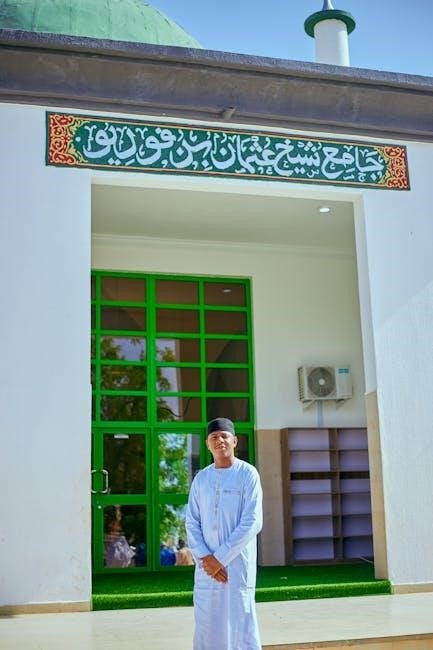Troubleshooting your Mitsubishi air conditioner can save time and money by addressing minor issues before they escalate. This guide provides step-by-step solutions for common problems like error codes‚ power outages‚ and cooling inefficiencies‚ ensuring your unit runs smoothly year-round.
Importance of Regular Maintenance
Regular maintenance is crucial for optimal performance and reliability of your Mitsubishi air conditioner. Cleaning air filters‚ inspecting drain pumps‚ and checking for refrigerant leaks can prevent major issues. Neglecting maintenance may lead to reduced efficiency‚ higher energy bills‚ or even system failure. Scheduling routine checks ensures long-term performance‚ prevents unexpected breakdowns‚ and maintains a healthy indoor environment. Proper care extends the lifespan of your unit and keeps it running efficiently year-round.
Understanding Common Issues
Identifying common issues with your Mitsubishi air conditioner is key to effective troubleshooting. Problems like the unit not turning on‚ blowing hot air‚ or continuous cycling often stem from power outages‚ faulty components‚ or thermostat malfunctions. Recognizing these signs early allows for quick fixes‚ preventing further damage. This guide helps you diagnose and address these issues‚ ensuring your system operates efficiently and reliably throughout the year.

Common Error Codes and Their Solutions
Mitsubishi air conditioners use error codes to indicate specific issues. Referencing error code charts helps identify malfunctions‚ such as faulty sensors or compressors‚ and guides repairs effectively.
Interpreting Blinking Lights on the Remote Controller
Blinking lights on the Mitsubishi remote controller indicate specific issues. For example‚ continuous blinking may signal a malfunction‚ while alternating patterns can point to sensor or compressor faults. Referencing the error code chart in the user manual helps identify the problem. If error codes persist‚ consult an authorized dealer or technician to resolve the issue and prevent further damage to the unit. Timely action ensures reliable performance and safety.
Understanding Error Code Charts for Mr. Slim Models
Mitsubishi Mr. Slim models use error code charts to diagnose issues. These charts list specific codes‚ such as those for drain pump malfunctions or sensor problems‚ along with solutions. For example‚ a code indicating high resistance in the drain pump (normal resistance is ~82 ohms) may require replacing the indoor controller board. Always consult the chart in the user manual for accurate troubleshooting and to address issues effectively.
Resolving Issues Indicated by Error Codes
Error codes on Mitsubishi air conditioners indicate specific malfunctions‚ such as drain pump issues or sensor damage. Refer to the error code chart in the user manual to identify the problem. For example‚ a drain pump malfunction may require replacing the pump or checking resistance levels. Addressing these issues promptly prevents further damage. If unsure‚ consult a professional to avoid risks like water leakage or electric shock and ensure safe‚ effective repairs.

Power-Related Issues
Power-related issues‚ such as outages or supply problems‚ can prevent your Mitsubishi AC from functioning. Check circuit breakers‚ fuses‚ and ensure a stable power supply for proper operation.
Troubleshooting Power Outages
If your Mitsubishi AC doesn’t turn on‚ check the power supply first. Ensure the circuit breaker isn’t tripped and all fuses are intact. Verify that the outlet is working by plugging in another device. If issues persist‚ inspect for internal component failures or loose connections. Consult a professional if the problem isn’t resolved‚ as advanced electrical faults may require expert attention.
- Check the circuit breaker for tripped switches.
- Verify the outlet is functioning properly.
- Inspect for loose or damaged power cords.
Checking Circuit Breakers and Fuses
Start by locating your home’s circuit breaker or fuse box. Check if the breaker controlling your AC has tripped; if so‚ reset it. Ensure no fuses are blown or damaged. If the issue persists‚ inspect for loose connections or overloaded circuits. Always turn off the power before handling electrical components. Consulting a licensed electrician is recommended if problems remain unresolved.
- Locate the circuit breaker or fuse box.
- Check for tripped breakers or blown fuses.
- Reset or replace as needed.
Ensuring Proper Power Supply
Ensure your Mitsubishi air conditioner receives a stable power supply. Check the power cord and outlet for damage or loose connections. Verify that the voltage matches the unit’s requirements to prevent damage. Avoid using extension cords unless necessary‚ and ensure the circuit is dedicated to the AC. Regularly inspect for signs of wear or tripped breakers to maintain consistent operation.
- Check power cord and outlet connections.
- Verify voltage matches unit specifications.
- Avoid using damaged or overloaded circuits.

Remote Control Problems
Address issues like battery depletion‚ synchronization errors‚ or faulty remote sensors. Ensure proper battery installation and check for signal obstructions. Replace batteries or re-sync the remote if necessary.
Replacing Batteries
Low battery levels often cause remote control issues. Replace the batteries with new ones of the correct type (usually AA or AAA). Ensure proper installation by matching the + and ― terminals. Avoid using damaged or mixed batteries‚ as this can reduce performance. After replacement‚ test the remote to confirm it communicates with the air conditioner. Regularly checking and updating batteries prevents unexpected malfunctions.
Resynchronizing the Remote Controller
If the remote controller stops working‚ resynchronize it by pressing and holding the “RESET” or “SYNC” button (located at the back or bottom) for 3-5 seconds. Ensure the remote is within range of the indoor unit. If this doesn’t work‚ unplug the air conditioner‚ wait 30 seconds‚ and plug it back in. This process resets the connection. Always refer to the user manual for specific instructions‚ as procedures may vary by model.
Addressing Remote Control Malfunctions
Malfunctions in the remote controller can disrupt air conditioner operation. Check for physical damage or interference from other devices. Ensure the remote is properly paired with the indoor unit. If issues persist‚ consult the user manual for-specific instructions or contact a certified technician. Regular maintenance and proper handling can prevent such malfunctions‚ ensuring seamless control over your Mitsubishi air conditioner’s performance.
Thermostat and Temperature-Related Issues
Thermostat malfunctions can cause inconsistent cooling or heating. Calibration errors or incorrect temperature settings may disrupt performance. Addressing these issues ensures precise temperature control and optimal comfort levels.
Calibrating the Thermostat
Calibrating the thermostat ensures accurate temperature control. Start by resetting the thermostat to its default settings. Check if the displayed temperature matches the actual room temperature. If not‚ adjust the calibration settings following the manufacturer’s instructions. Ensure the thermostat is synchronized with the AC unit for proper communication. Regular calibration prevents inconsistent cooling or heating‚ maintaining optimal performance and energy efficiency. Always refer to the user manual for specific calibration procedures to avoid errors.
Adjusting Temperature Settings
Adjusting temperature settings on your Mitsubishi air conditioner ensures optimal comfort and efficiency. Use the remote control or thermostat to set your desired temperature. Ensure the thermostat is set to the correct mode (cooling or heating). Check that the temperature displayed matches your actual needs. If the AC isn’t cooling or heating properly‚ verify that the temperature difference isn’t too extreme. Small adjustments can make a big difference in performance and energy use. Always allow the system time to respond to changes.
Fixing Thermostat Communication Issues
Thermostat communication issues can disrupt your Mitsubishi air conditioner’s performance. Check for loose or damaged wires between the thermostat and indoor unit. Ensure the thermostat is properly powered and configured. If the thermostat isn’t syncing‚ reset it by turning it off and on. For advanced issues‚ consult a professional to diagnose wiring faults or replace faulty components. Proper communication is essential for accurate temperature control and system efficiency.

Common Operational Issues
Common operational issues with Mitsubishi air conditioners include the unit not turning on‚ continuous on/off cycling‚ or the indoor unit failing to start. Addressing these promptly ensures smooth operation.
Why the AC Might Not Turn On
Your Mitsubishi AC might not turn on due to power issues‚ such as tripped circuit breakers or blown fuses. Remote control malfunctions or dead batteries can also prevent operation. Additionally‚ thermostat settings or internal component failures‚ like a faulty compressor or controller board‚ may cause the unit to remain off. Always check the power supply‚ remote functionality‚ and thermostat settings before consulting a professional for internal repairs.
Addressing Continuous On/Off Cycling
If your Mitsubishi AC continuously cycles on and off‚ it may indicate a faulty thermostat‚ dirty air filters‚ or sensor malfunctions. Check if the thermostat is calibrated correctly and ensure air filters are clean for proper airflow. Verify that the drain pump and sensors are functioning as they should. If issues persist‚ consult the error code chart or contact a professional to diagnose internal component failures or wiring problems.
Fixing the Indoor Unit Not Turning On
If the indoor unit of your Mitsubishi AC isn’t turning on‚ check for power issues‚ such as blown fuses or tripped circuit breakers. Ensure the thermostat is set correctly and the remote control has functioning batteries. Verify that the unit is properly synchronized with the outdoor unit. If these steps fail‚ inspect for internal component failures‚ such as damaged sensors or a faulty PCB‚ and consult a professional if needed.

Performance and Cooling Issues
Address cooling inefficiencies by checking air filters‚ ensuring proper airflow‚ and inspecting for refrigerant leaks. Faulty compressors or thermostat malfunctions can cause hot air output‚ requiring professional diagnosis and repair.
Why the AC is Blowing Hot Air
If your Mitsubishi AC is blowing hot air‚ it may be due to a dirty air filter‚ faulty compressor‚ or malfunctioning thermostat. Check for clogged filters‚ ensure proper refrigerant levels‚ and inspect the condenser coils for dirt. Additionally‚ a faulty thermostat or damaged drain sensor can disrupt cooling. Addressing these issues promptly can restore proper cooling and prevent further system damage.
Improving Airflow and Cooling Efficiency
Ensure proper airflow by cleaning or replacing dirty air filters and checking for blocked vents. Regularly inspect and clean condenser coils to maintain efficiency. Keep the unit well-maintained‚ and ensure proper installation to optimize performance. Addressing these factors can significantly enhance cooling efficiency and prevent common operational issues.
Diagnosing Faulty Compressors

A faulty compressor can cause your Mitsubishi AC to blow hot air or fail to cool effectively. Look for symptoms like unusual noises‚ overheating‚ or error codes related to compressor malfunction. Check for refrigerant leaks or blockages in the system. If issues persist‚ consult a professional to inspect and repair or replace the compressor‚ as improper handling can lead to further damage or safety hazards.

Maintenance Tips
Regular maintenance is crucial for optimal performance. Clean air filters monthly‚ inspect drain pumps for blockages‚ and check for refrigerant leaks to ensure efficiency and longevity.
Cleaning Air Filters
Cleaning air filters is essential for maintaining your Mitsubishi AC’s performance. Dirty filters reduce airflow and efficiency‚ increasing energy bills. Turn off the unit‚ remove the filters‚ and vacuum or wash them gently. Allow them to dry before reinstalling. Clean filters monthly during heavy use to ensure optimal cooling and system longevity.
Inspecting and Replacing Drain Pumps
Regularly inspect the drain pump to prevent water leakage and system malfunctions. Check for blockages or damage and clean the pump if necessary. If the pump is faulty‚ replace it to avoid water overflow and potential electrical issues. Ensure the unit is powered off before performing any maintenance. Refer to your user manual for specific instructions and always use genuine Mitsubishi parts for replacements.
Checking for Refrigerant Leaks
Refrigerant leaks can reduce cooling efficiency and increase energy bills. Inspect hoses and connections for visible damage or hissing sounds. Use a leak detection kit to identify escaping refrigerant. If a leak is found‚ turn off the unit and consult a professional for repairs. Always use genuine Mitsubishi parts to ensure system compatibility and safety. Regular checks help maintain optimal performance and prevent costly damage.

Advanced Troubleshooting
Address internal component failures‚ interpret complex error codes‚ and resolve advanced issues like damaged sensors or faulty compressors. Improper repairs can lead to safety hazards‚ so consult professionals for critical fixes;
Identifying Internal Component Failures
Identifying internal component failures involves diagnosing issues like faulty compressors‚ damaged sensors‚ or malfunctioning circuit boards. Look for symptoms such as unusual noises‚ reduced performance‚ or error codes. Check resistance levels and consult error code charts for precise identification; Addressing these issues promptly prevents further damage and ensures safety. Always consider professional assistance for critical repairs to avoid risks like water leakage or electric shock.
Replacing the Indoor Controller Board
Replacing the indoor controller board is necessary when internal components fail. Look for error codes or malfunctions. Power off the unit‚ disconnect wires‚ and replace the board. Reconnect and test operation. Proper installation prevents further issues. Improper handling can cause electric shock or water leakage. Ensure correct installation for safe and effective performance. Always follow safety guidelines.
Addressing Damaged Drain Sensors
A damaged drain sensor can cause water leakage or system malfunctions. Check for error codes or unusual operation. Inspect the sensor for blockages or damage. Clean or replace it if necessary. Ensure proper installation to avoid water overflow. If resistance levels deviate from normal (e.g.‚ 82 ohms)‚ replacement is required. Always power off the unit before servicing to prevent electric shock or further damage.

When to Call a Professional
Call a professional if you encounter major system failures‚ water leakage risks‚ or complex repairs beyond basic troubleshooting steps to ensure safety and prevent further damage.
Recognizing Major System Failures
Major system failures‚ such as internal component breakdowns or recurring error codes‚ indicate the need for professional intervention. Issues like faulty compressors‚ damaged sensors‚ or persistent water leakage require expert diagnosis to prevent further damage or safety risks like electric shock. If basic troubleshooting doesn’t resolve the issue‚ consult a certified technician to address complex repairs and ensure system reliability.
Preventing Water Leakage and Electric Shock
Prevent water leakage by regularly inspecting drain systems and ensuring proper installation. Address blockages promptly to avoid overflow. For electric shock prevention‚ check for worn insulation or exposed wiring and secure all connections. Regular maintenance by certified professionals can identify potential risks early‚ ensuring safe and reliable operation of your Mitsubishi air conditioner.
Consulting Authorized Dealers
Consulting authorized Mitsubishi dealers ensures professional diagnosis and repair‚ preventing further damage. They provide genuine parts and expert solutions for complex issues. Contact dealers for severe system failures or safety concerns‚ such as water leakage or electric shock risks. Their expertise guarantees reliable and efficient service‚ maintaining your air conditioner’s performance and longevity.
This guide provides essential troubleshooting steps for Mitsubishi air conditioners‚ helping users resolve common issues efficiently. Regular maintenance and timely repairs ensure optimal performance and longevity of your unit.
Summarizing Key Troubleshooting Steps
Start by checking the power supply and remote control functionality. Inspect error codes and address them promptly. Clean air filters and ensure proper drainage. Regular maintenance‚ like inspecting refrigerant levels and replacing worn parts‚ is crucial. If issues persist‚ consult the user manual or contact a professional to prevent further damage and ensure long-term efficiency.
Ensuring Long-Term Performance
Regular maintenance is key to extending your Mitsubishi AC’s lifespan. Clean air filters monthly and inspect the drain pump to prevent blockages. Schedule annual professional inspections to identify potential issues early. Proper refrigerant levels and energy-efficient settings also enhance performance. Follow the manufacturer’s guidelines for optimal operation‚ ensuring reliable cooling and minimizing wear and tear over time.